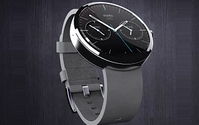
An e-reader may not make a great fashion accessory, but its fortunes can help predict the rise and fall of nascent wearable devices and home automation gadgets. That’s according to a new
report, “How to Ride the Rise and Fall of Digital Devices,” by James McQuivey, VP and principal analyst at Forrester.
McQuivey’s thesis is that today’s digital devices
-- from e-readers to MP3 players to the Flip camera -- gain mass appeal and then are cast aside more quickly than ever. Because of the inherent risks, marketers should forget about building hardware
themselves and focus on using devices “as a bridge over which to extend a branded relationship,” he argues.
Hype around the emerging wearables market and home and health automation
reached new heights in June, as Google unveiled new Android-based smartwatches from LG and Samsung, along with Android Auto and Google Fit, among other new platforms. And while not mentioned at its
I/O conference, Google Glass began selling in the U.S. in mid-April.
advertisement
advertisement
Apple, meanwhile is expected to introduce the much-rumored iWatch this fall, and earlier in June announced its push into
the Internet of Things with its HealthKit and HomeKit platforms. So what wearable or other devices that arise from these and similar initiatives will actually have staying power?
McQuivey
argues that single-purpose devices, like e-readers, will be the most vulnerable to rapid obsolescence. In that vein, he predicts that fitness devices -- which are in ascendance now -- are headed for a
fall. As an example, he points to the Nike FuelBand, which is being phase out. By contrast, Google has partnered with LG to put its Android Wear on their smartwatches instead of building the hardware
itself.
Forrester expects wearables to flourish through 2016, “when their functionality is assumed by other devices you are already carrying anyway, from obvious contenders like
smartphones to more intriguing ones, like sensor-laden headphones.”
Home automation and control will have a more gradual ramp, but get rolled up quickly. Technologies geared to
subcategories like home security, the digital kitchen and the digital bathroom will each see their own cycle of rapid over-investment and rapid decline before getting folded into broader service
offerings.
Facebook’s acquisition of Oculus VR in March instantly boosted the buzz around virtual reality as The Next Big Thing. But the Forrester report
throws cold water on that idea. “We confidently assert that it will take another decade for virtual reality to make significant progress outside of the obvious gaming applications we can already
identify today because it meets our criteria so poorly,” it states.
Where does that leave Google Glass -- today more an object of ridicule than desire? Surprisingly, the research firm
expects a brighter future for augmented reality, while acknowledging Google Glass has been a marketing flop to date. That’s mainly because AR isn’t tied to a single device and can serve as
a digital layer over everyday life.
Augmented reality already seems to have come and gone as a marketing tactic, with much of the buzz generated by a specially outfitted Lego toy box three
years ago. It’s hard to see the technology making a comeback in a couple of years, as the report suggests.
McQuivey overall recommends that brands take the safer path of developing
content and services for the next-generation devices, and leave the hardware manufacturing to Apple, Samsung and other tech players. But even if companies are only creating apps, they’ll still
have to make bets on which consumer technologies will go beyond the early adopter crowd. The ride will inevitably still have bumps.